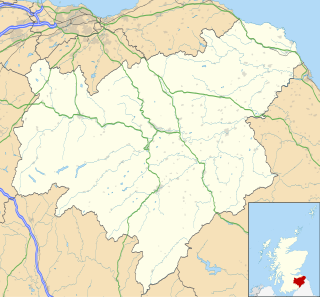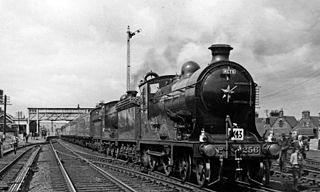
The Scottish Borders is one of 32 council areas of Scotland. The council area occupies approximately the same area as the historic shires of Berwickshire, Peeblesshire, Roxburghshire, and Selkirkshire. It is bordered by West Lothian, Edinburgh, Midlothian, and East Lothian to the north, the North Sea to the east, Dumfries and Galloway to the south-west, South Lanarkshire to the west, and the English ceremonial counties of Cumbria and Northumberland to the south. The largest settlement is Galashiels, and the administrative centre is Newtown St Boswells.

Jedburgh is a town and former royal burgh in the Scottish Borders and the traditional county town of the historic county of Roxburghshire.

Roxburghshire or the County of Roxburgh is a historic county and registration county in the Southern Uplands of Scotland. It borders Dumfriesshire to the west, Selkirkshire and Midlothian to the northwest, and Berwickshire to the north. To the southwest it borders Cumberland and to the southeast Northumberland, both in England.

The Waverley Route was a railway line that ran south from Edinburgh, through Midlothian and the Scottish Borders, to Carlisle. The line was built by the North British Railway; the stretch from Edinburgh to Hawick opened in 1849 and the remainder to Carlisle opened in 1862. The line was nicknamed after the immensely popular Waverley Novels, written by Sir Walter Scott.

Nisbet is a small hamlet on the B6400, in Roxburghshire, along the River Teviot, in the Scottish Borders area of Scotland. It is located 5.5 kilometres (3.4 mi) north of Jedburgh and 5 kilometres (3.1 mi) south of Roxburgh.

Tweedmouth railway station was a railway station which served the Tweedmouth area of Berwick-on-Tweed in Northumberland, England. It was located on the East Coast Main Line. As well as a railway station for passengers, it was also the main service yard and goods yard between Newcastle upon Tyne and Edinburgh. Also Tweedmouth station was the terminus for the Tweed Valley Railway line, which connected the East Coast Main Line with the Waverley Line at Newtown St. Boswells. The station lies to the south of the Royal Border Bridge.
The Duns Branch and the Berwickshire Railway together formed a through railway route from Reston, near Berwick-upon-Tweed, to St Boswells in the Scottish Borders. The line was promoted in two stages. The first was from Reston on the Edinburgh to Berwick main line to Duns ; it opened by the North British Railway in 1849.

Munro's of Jedburgh was a bus company, which operated local and regional bus services in the City of Edinburgh, East Lothian, Midlothian and Scottish Borders, Scotland, as well as Northumberland and Tyne and Wear, England. The company was closed in July 2013, following a retendering exercise by Scottish Borders Council.
The Kelso Branch was a 23.5 miles (37.8 km) twin track branch railway in Northumberland, England and Roxburghshire, Scotland that ran from Tweedmouth on the East Coast Main Line via seven intermediate stations to Kelso.

Hawick railway station served the town of Hawick, Scottish Borders, Scotland from 1849 to 1969 on the Waverley Route. It has been proposed that it could re-open as an extension to the Borders Railway, and a feasibility study is currently underway.

Crailing is a village on the A698, in Teviotdale, 4m east of Jedburgh in the Scottish Borders area of Scotland, in the historic county of Roxburghshire.
The Selkirk and Galashiels Railway was a railway company that built a branch line connecting Selkirk, Scottish Borders, with the mainline network at Galashiels. The 5-mile (8.0 km) line opened in 1856 and was well used in the period down to 1914. Road transport from about 1923 became a serious competitor and the usage of the line declined steeply. Economy measures did little to retrieve the situation and the passenger service was withdrawn in 1951. Goods traffic continued for a period, but in 1964 that too was withdrawn. There is no railway use of the line now.
The Kelso Line was a ten-and-a-half-mile (16.9 km) long North British Railway built double track branch railway line in the Borders, Scotland, that ran from a junction south of St. Boswells on the Waverley Line to Kelso via three intermediate stations, Maxton, Rutherford and Roxburgh Junction where a branch line to Jedburgh joined the line.

The Railway of Kelso and Jedburgh branch lines was a 'network' of three distinct railway services serving Kelso in the Scottish Borders.

Kelso Hospital, also known as Inch Hospital, is a health facility at Inch Road in Kelso, Scotland. It is managed by NHS Borders.

Nisbet railway station served the hamlet of Nisbet, Scottish Borders, Scotland from 1856 to 1948, on the Jedburgh Railway.

Jedfoot railway station served the town of Jedburgh, Scottish Borders, Scotland from 1856 to 1948 on the Jedburgh Railway.

The Council Headquarters is a municipal building in Newtown St Boswells, in the Scottish Borders council area in Scotland. It serves as the headquarters of Scottish Borders Council.
















